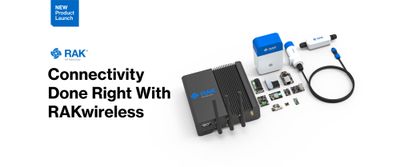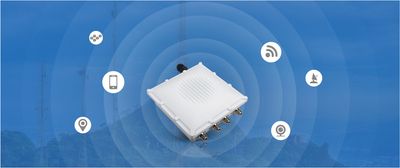IoT Networks: Everything You Need to Know
Our world is increasingly interconnected, thanks to IoT Networks. These networks allow a myriad of devices to communicate and share data seamlessly, from our homes to our cars, and even our health and wellness gadgets.
In this blog, we will explore the following topics:
- What is an IoT network?
- How does an IoT network operate?
- Different types of IoT networks
We will also discuss practical examples of IoT devices and scenarios, giving you a glimpse into how these networks influence our daily experiences. Moreover, we'll offer guidance on selecting an appropriate network for your needs, considering aspects like cost, energy usage, data transfer limits, and more.
What is an IoT Network and How Does It Work?
An IoT network is a system that connects a multitude of devices, enabling them to collect and share data seamlessly. The operation of these networks can be broken down into three key steps:
- Data Collection: IoT devices, embedded with sensors and software, gather data from their surroundings.
- Data Transmission: The devices then transmit this data over the network, which can be either wired or wireless.
- Data Processing: The transmitted data can be analyzed locally or sent to the cloud for further processing, leading to actionable insights.
For instance, a smart thermostat collects data about temperature and humidity levels in your home. This data is then sent via the IoT network to a cloud-based application. The application processes the data and adjusts your home's heating or cooling system accordingly.
An IoT network works as the crucial link that allows our homes, cars, and even health and wellness devices to become'smart' and interconnected.
Types of IoT Networks
Understanding the different types of IoT networks is crucial to finding the right IoT network solution for your needs. Here's a rundown of some of the most common types.
Wired & Short Range Wireless Networks
Wired and short-range wireless networks are often used in IoT networks where devices are located close to each other. These networks allow IoT devices to communicate directly with each other or with a central hub, making them ideal for applications like smart homes or industrial automation.
M2M – 2G, 3G, 4G & 5G Networks
Machine-to-machine (M2M) networks use cellular technology to connect IoT devices. This category includes 2G, 3G, 4G, and the latest, 5G networks. Each subsequent generation offers faster speeds and greater capacity, enabling more data to be transmitted between IoT devices.
LPWAN – Low Power Wide Area Networks
Low Power Wide Area Networks (LPWAN) are designed for long-range communications at a low bit rate. They are highly energy-efficient, making them perfect for IoT devices that need to operate for long periods without recharging. Examples of LPWAN technology include SigFox and LoRaWAN®.
NB-IoT (Narrow Band IoT)
NB-IoT is a type of LPWAN technology designed specifically for IoT applications. It uses a narrow frequency band to provide wide area coverage and deep penetration, making it suitable for IoT devices located in remote or hard-to-reach areas.
Disruptive Public Networks
Disruptive public networks are emerging technologies that aim to provide free or low-cost connectivity for IoT devices. They leverage existing infrastructure, such as Wi-Fi hotspots or Bluetooth beacons, to create a network of connected devices.
Image caption: There are various types of IoT networks with their unique characteristics and potential applications.
Sample on IoT Devices & Scenarios
Let's explore how IoT networks are applied in real-world scenarios.
1. Tunnel
Private 4G, 5G, and NB-IoT networks are used to provide high-speed wireless access. These networks ensure security for local data, guarantee bandwidth for specific devices, prevent data leakage, and offer wide-range IoT coverage. Additionally, they manage device access effectively.
2. Farm
In this setting, private LTE-M and 5G networks are employed. Like the tunnel scenario, they provide high-speed wireless access, secure local data, assure bandwidth for certain devices, prevent data leakage, and facilitate wide-range IoT coverage. Device access management is also a key feature.
3. Factory and Logistic Hub Scenario
Here, private LTE and 5G networks are utilized. They offer high-speed wireless access, ensure local network security, guarantee bandwidth for particular devices, and prevent data leakage. A stable redundancy data path is provided for data safety, and device access is managed efficiently.
These scenarios demonstrate how diverse IoT networks and devices can be tailored to suit various needs and environments. Read: Successful IoT deployments, research, and solution
How to Choose the Right Network
Selecting an appropriate IoT network solution for your project can be a complex task. Here are some key factors to consider:
Bandwidth Requirements
Identify whether your application requires wide-band data or narrowband applications. For wide-band data, public networks like LTE, 4G, and 5G are typically used, while private networks often use WiFi. For narrowband applications, consider public LPWAN options like NB-IoT or Cat-M, or private options such as LoRaWAN.
Cost Considerations
Traditional M2M networks using 2G, 3G, 4G, and 5G may come with high equipment and subscription costs. On the other hand, LPWAN technologies like SigFox and LoRaWAN aim to offer cost-effective solutions for IoT devices.
Energy Consumption
Energy efficiency is critical for IoT networks, particularly for battery-operated IoT devices. LPWAN technologies like SigFox and LoRaWAN are designed to be energy-efficient, offering a viable solution for such devices.
Coverage and Reliability
Consider the network's coverage and reliability. Traditional M2M networks offer global coverage, while emerging public networks like Helium and Amazon Sidewalk present new possibilities for IoT connectivity.
Understanding your project's specific needs and constraints, along with the strengths and weaknesses of each type of IoT network, will guide you in making the best choice for your IoT network solution.
Final Thoughts: Empowering the Future of IoT
Navigating the array of IoT networks and finding the right IoT network solution for your specific needs can be challenging. However, understanding the strengths of options like LPWAN, traditional M2M networks, and newer networks can provide crucial guidance. IoT devices are steadily becoming the backbone of our interconnected world, and the right IoT network can empower these devices to operate at their full potential.

Frequently Asked Questions
1. What are IoT Networks?
IoT Networks refer to the systems of interconnected IoT devices that communicate and share data with each other. These networks can use various technologies, including LPWAN, LoRaWAN, WiFi, and cellular data.
2. What are disruptive public networks in IoT?
Disruptive public networks in IoT refer to new network solutions that challenge traditional models. Examples include Helium and Amazon Sidewalk, which offer decentralized and community-based network coverage for IoT devices.
3. Is 5G IoT?
5G is not IoT, but it's a vital technology that supports IoT. It provides faster speed and lower latency than its predecessors, making real-time data transfer for IoT devices more efficient.
4. Does IoT need the Internet?
Not all IoT devices require the internet. Some can communicate using other types of networks like Bluetooth or Zigbee. However, for IoT devices to communicate over long distances or to access cloud services, internet connectivity is usually needed.
5. What is the role of LoRaWAN in IoT?
LoRaWAN is a type of LPWAN technology used in IoT. It offers long-range communication with low power consumption, making it ideal for battery-operated IoT devices in areas where WiFi or cellular connectivity might not be available.
Learn more about the difference between LoRa® and LoRaWAN.




